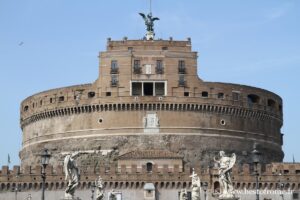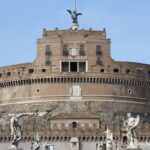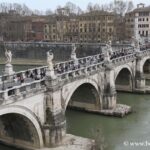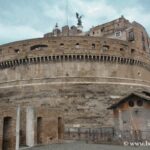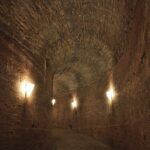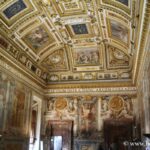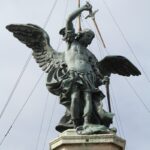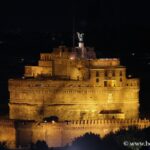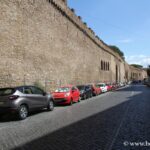Name in Italian: Castel Sant’Angelo
Discover the Castel Sant’Angelo, one of the most fascinating monuments in Rome, located on the right bank of the Tiber, near the Borgo district, the Vatican, and the St. Peter’s Basilica.
Its central structure is formed by the ancient Mausoleum of Hadrian, built in the 2nd century AD, a circular tomb transformed into a fortress after the fall of the Roman Empire. This building blends Roman history, legends, and unique architecture.
The visit to Castel Sant’Angelo and the nearby Saint Angel Bridge ranks 12th in our Top 30 Things to See in Rome.
Castel Sant’Angelo Hours and Useful Information
Castel Sant’Angelo
Lungotevere Castello, 50
Open daily from 9:00 AM to 7:30 PM (ticket office closes at 6:30 PM).
Closed on December 25, May 1, and January 1.
Full price: €15, reduced €2 (Europeans aged 18-25), free for those under 18, disabled individuals, etc.
Sources and Links
- Official website: www.castelsantangelo.com
- Visit and photos: www.rome-roma.net
- Guided tours of the castle and nearby sites: www.getyourguide.com
From Hadrian’s Mausoleum to Fortified Castle
The Mausoleum of Hadrian, around which the castle was built, was constructed for Emperor Hadrian’s family by the architect Demetriano between 117 and 138 AD. A bridge, the Pons Aelius, was built at that time—now replaced by the Saint Angel Bridge—to cross the Tiber, connecting the Campus Martius in Rome’s historic center to the mausoleum. The mausoleum featured a square base with a cylindrical structure at its center, which became the foundation of the castle.
Atop the mausoleum stood a statue of the Emperor, depicted as the Sun God, with a bronze chariot.
In the 5th century, bastions were added to integrate it into the Aurelian Walls, turning it into a defensive structure. The mausoleum evolved into a fortress during the Middle Ages, and in 1277, it became the property of the Church. The Church transformed it into a fortified prison and built an elevated fortified passage, the Passetto, to connect it to the Vatican district.
The Legend of the Castle’s Angel
The castle’s name comes from a miraculous apparition during the plague of 590 AD. According to legend, Pope Gregory the Great, praying in a procession, had a vision of an angel sheathing its sword. He interpreted this as a sign that the plague would soon end. Following this event, a wooden statue of an angel with a sword was placed atop the castle.
This statue has undergone many versions over time, including some in marble. A bronze version was melted down in 1527 to forge weapons. The current statue, the sixth, dates to 1753.
Visiting the Castle’s Interior
The castle’s interior consists of five levels, featuring numerous rooms from the Roman era as well as several Renaissance rooms covered in frescoes. Much of the original mausoleum structure remains, including the ancient Roman walls visible from the outside.
In the basement lies the Roman atrium, which once housed a colossal statue of Emperor Hadrian. A circular, ascending tunnel leads to a corridor that opens into the burial chamber at the heart of the mausoleum. This square room with three niches, once clad in marble, held the ashes of Hadrian and other emperors, including the Antonines and Severans, up to Caracalla.
The Passetto: Secret Passage to the Vatican
The Passetto (meaning “small passage” in Italian) is a section of the 9th-century Leonine Walls, connecting the castle to the Vatican’s Apostolic Palaces. Inside the wall, an 800-meter-long corridor was built in the 14th century to allow the Pope and his court to take refuge in the castle during times of danger.
Except for rare openings or organized tours, the Passetto is not accessible to the public. However, a good portion of it can be seen from the castle’s upper floors.
Photo Gallery of the Castle
- Castel Sant’Angelo
- Ponte Sant’Angelo in Rome
- The structure of the mausoleum
- Circular ramp of the mausoleum
- Paolina room
- The terrace with the angel
- Seen at night and at height
- The passetto
Guided Tours of Castel Sant’Angelo and Ideas
Suggestions for guided tours of Castel Sant’Angelo:
Selection of Accommodations Near Castel Sant’Angelo
A selection of hotels, rooms, and apartments near Castel Sant’Angelo, sorted by price and distance from the castle:
- Good hotels and accommodations sorted BY PRICE within 600
meters of Castel Sant’Angelo - Good hotels and accommodations sorted BY DISTANCE from
Castel Sant’Angelo
Tips for Visiting and FAQ
What to See First When Visiting Castel Sant’Angelo?
- The Angel’s Terrace: Located at the top, it offers a stunning panoramic view of Rome, including the Saint Angel Bridge, next to the angel statue.
- The Passetto (exterior view): Visible from the upper floors.
- Hadrian’s Burial Chamber: A square room at the heart of the mausoleum with three niches, which once held Hadrian’s ashes.
- In the basement: The Roman Atrium and the Colossal Head of Hadrian, the circular tunnel leading to the chamber.
- The Renaissance Rooms and their Frescoes, including the Sala Paolina.
- The outer walls, remnants of the Aurelian Walls, and the castle’s fortifications.
How Long Does It Take to Visit Castel Sant’Angelo?
Plan for 1 to 2 hours to explore the five levels.
What’s the Best Time to Visit Castel Sant’Angelo?
Late afternoon offers beautiful light over the Tiber and the Saint Angel Bridge from the terrace.
Can You Visit the Passetto?
No, the Passetto is closed to the public for safety reasons. It’s only accessible on rare occasions.
What’s Near Castel Sant’Angelo?
- Right in front of the castle, the Saint Angel Bridge with its stunning statues spans the Tiber.
- Very close to the castle is the Vatican, less than a 10-minute walk, including St. Peter’s Square with St. Peter’s Basilica and the Vatican Museums.
- The Borgo district.
Are There Guided Tours of the Castle, Including Combined Tours?
Yes, guided tours are available, for example, through the GetYourGuide portal. Some combine the visit with St. Peter’s Basilica and/or the Vatican Museums.
How to Reach Castel Sant’Angelo and Map
If you see this after your page is loaded completely, leafletJS files are missing.







